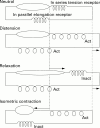Perception of changes in wall tension of the proximal stomach in humans
- PMID: 11454795
- PMCID: PMC1728394
- DOI: 10.1136/gut.49.2.203
Perception of changes in wall tension of the proximal stomach in humans
Abstract
Background: Hypersensitivity to distension of the stomach is a frequent finding in functional dyspepsia. During gastric distension studies both wall tension and elongation are increased.
Aim: We wished to distinguish changes in wall tension from changes in elongation in the genesis of perception of mechanical stimuli originating from the proximal stomach in healthy subjects.
Subjects and methods: Twenty six volunteers were studied using gastric barostat and antroduodenal manometry. In 14 subjects, stepwise isobaric and isovolumetric distensions were performed before and during erythromycin infusion. In all volunteers, on a separate occasion, phasic contractions of the proximal stomach were detected as intraballoon pressure increases during fixed volume inflation. These contractions were matched with perception changes during two 10 minute periods, before and during administration of erythromycin.
Results: Erythromycin significantly lowered the perception and discomfort thresholds during stepwise gastric distension. During fixed volume inflation, erythromycin increased the number and amplitude of fundic contractions and enhanced their perception from 51.1 (7.4)% to 64.0 (4.7)%. The proportion of perception score increases coinciding with fundic contractions increased from 47.3 (0.7)% to 81.5 (0.5)%. The amplitude of correctly identified isolated fundic pressure waves was higher compared with non-identified waves.
Conclusions: These results support the hypothesis that changes in gastric wall tension may be involved in the genesis of symptoms originating from the stomach.
Figures





References
MeSH terms
Substances
LinkOut - more resources
Full Text Sources
